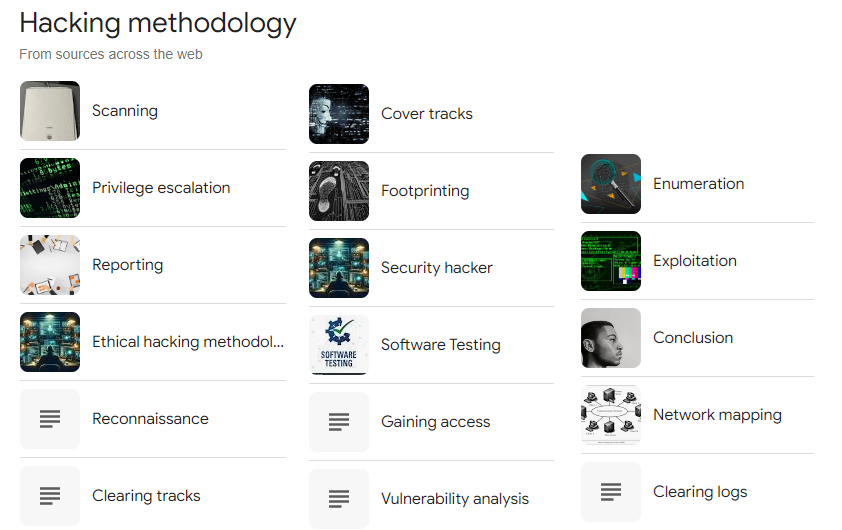The methodology followed by hackers, particularly those involved in malicious activities, typically involves a series of systematic steps designed to breach security defenses, exploit vulnerabilities, and achieve their objectives.

Here is an overview of a common hacking methodology:
1. Reconnaissance (Information Gathering)
Active Reconnaissance
- Scanning and Probing: Actively scanning the target’s network to gather information about open ports, services, and systems using tools like Nmap.
- Social Engineering: Engaging with employees or using phishing techniques to gather information directly from individuals.
Passive Reconnaissance
- Open Source Intelligence (OSINT): Collecting information from publicly available sources, such as websites, social media, and public records, without interacting with the target.
- Footprinting: Gathering details like domain names, IP addresses, and network topology.
2. Scanning
- Network Scanning: Identifying live hosts, open ports, and services running on the network using tools like Nmap or Angry IP Scanner.
- Vulnerability Scanning: Using tools like Nessus or OpenVAS to identify known vulnerabilities in the target’s systems.
3. Gaining Access (Exploitation)
- Exploiting Vulnerabilities: Using identified vulnerabilities to gain unauthorized access. This can involve exploiting software bugs, misconfigurations, or weak passwords.
- Phishing Attacks: Crafting email or web-based attacks to trick users into providing credentials or executing malicious software.
- Brute Force Attacks: Attempting to crack passwords by systematically trying a large number of possibilities.
4. Maintaining Access
- Installing Backdoors: Deploying backdoor programs or rootkits to ensure continued access even if the initial vulnerability is patched.
- Privilege Escalation: Exploiting additional vulnerabilities to gain higher-level access within the system, such as root or administrative privileges.
5. Covering Tracks
- Log Deletion: Deleting or altering system logs to remove evidence of the attack.
- Using Proxies/VPNs: Hiding the attacker’s IP address by routing traffic through multiple servers to avoid detection.
6. Exfiltration and Exploitation
- Data Exfiltration: Stealing sensitive data, such as personal information, financial data, or intellectual property.
- Launching Further Attacks: Using the compromised system as a base to attack other systems within the network (pivoting).
- Implementing Malware: Installing ransomware, spyware, or other malicious software to disrupt operations, steal information, or demand ransom.
Tools Commonly Used by Hackers
- Reconnaissance Tools:
- Maltego: For OSINT and mapping relationships.
- theHarvester: For gathering emails, subdomains, and other information.
- Scanning Tools:
- Nmap: For network discovery and security auditing.
- Wireshark: For network traffic analysis.
- Exploitation Tools:
- Metasploit Framework: For developing and executing exploit code against a remote target machine.
- SQLmap: For automating the process of detecting and exploiting SQL injection vulnerabilities.
- Maintaining Access Tools:
- Netcat: For reading and writing data across network connections.
- Cobalt Strike: For post-exploitation and command and control.
- Covering Tracks Tools:
- Clearev: For clearing event logs on Windows systems.
- Auditpol: For managing and manipulating auditing policies.
Ethical Considerations
While understanding the methodology followed by hackers is crucial for cybersecurity professionals to defend against attacks, it’s important to note that engaging in unauthorized hacking activities is illegal and unethical. Ethical hacking, performed by professionals known as penetration testers, follows similar methodologies but within the boundaries of the law and with the explicit permission of the system owners.
Conclusion
Hackers follow a structured methodology that includes reconnaissance, scanning, gaining access, maintaining access, covering tracks, and exploiting the target. By understanding these steps, cybersecurity professionals can better anticipate and defend against potential attacks, ensuring the security and integrity of their systems and data.